Are you a Quiet Speculation member?
If not, now is a perfect time to join up! Our powerful tools, breaking-news analysis, and exclusive Discord channel will make sure you stay up to date and ahead of the curve.
Every few weeks, speculation begins to rise about the next Banned and Restricted Announcement. Whenever something actually does happen, I frequently see laments over being blindsided and calls for Wizards to implement a banning watchlist. While an official list will never happen as it would unduly influence the secondary market, I do think it useful to consider what might happen. Today, I'm going to make my own banning watchlist.
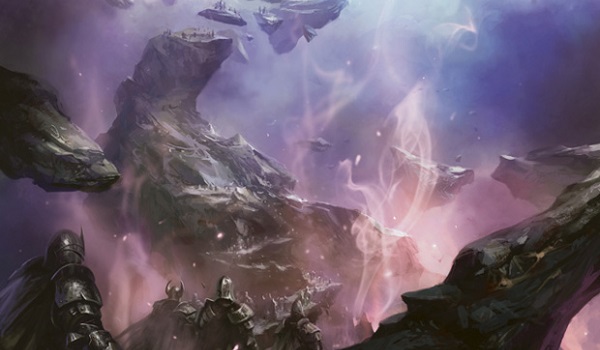
Truth be told, I don't expect anything to be banned or unbanned in the foreseeable future of Modern. Modern averages one unban every two years. Since 2018 saw two cards released, I'd be floored if anything else came off before 2020. The format is in a reasonably good place given the ebb and flow of deck speed, and nothing is dominating or consistently degenerate enough to justify action. Therefore, I have no reason to believe that whatever supposedly dangerous deck cannot be answered just by format adaptation.
However, there are cards that could be dangerous if the stars align next year. It will take a combination of the right printing, the right deck, widespread player adoption, or the right metagame shift to happen, but I think some cards are very close to getting the axe. By the same token, some cards are frequently discussed, but I cannot imagine them actually getting banned.
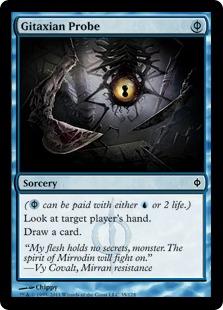 The Watchlist
The Watchlist
When considering what could or should be banned in Modern, it's important to remember Wizards' goals. They want a fun and diverse format to provide long-term value for Standard collections. As far as metagame speculation and competitive players are concerned, the important goals are diversity and speed. Wizards wants as many decks to be competitive as possible, and doesn't like non-interactive, consistent kills before turn four.
It is also important to note that Wizards tends to focus bans on enablers and engine cards rather than on payoffs. I don't think this has ever been explicitly stated, but a look through the history of bannings certainly lends credence. They also appear to prefer targeted bans against specific problem decks whenever possible, though that frequently isn't possible, as many problem cards happen to be splashed into multiple decks.
Faithless Looting
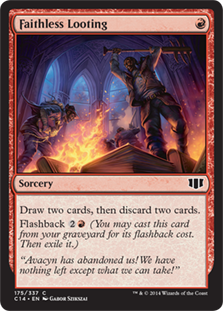 2018 has arguably been the year of Faithless Looting. Every time a new deck emerged it seemed to include the red draw spell. Mardu Pyromancer, Hollow One, Dredge, Bridgevine, Arclight Red, and numerous fringe strategies have all wielded Looting. In all these decks, the often reads "draw four cards." Tempo and velocity are far more important in Modern than something like card advantage, and there's nothing that facilitates either like Looting. Many Looting decks have been borderline degenerate and certainly unfair, so it makes sense to target the best enabler to make Modern more fair.
2018 has arguably been the year of Faithless Looting. Every time a new deck emerged it seemed to include the red draw spell. Mardu Pyromancer, Hollow One, Dredge, Bridgevine, Arclight Red, and numerous fringe strategies have all wielded Looting. In all these decks, the often reads "draw four cards." Tempo and velocity are far more important in Modern than something like card advantage, and there's nothing that facilitates either like Looting. Many Looting decks have been borderline degenerate and certainly unfair, so it makes sense to target the best enabler to make Modern more fair.
Why It Won't Be Banned
All those Looting decks have risen, had some time in the sun, and then faded away. For various reasons, none so far have been able to maintain strong metagame shares for more than a few months. The metagame has proven resilient, adapting and answering each deck in turn. Dredge is already on a downswing as Phoenix decks rise. We don't know if this will be true for Phoenix too, but the bottom line is that no Looting deck has been too much to handle so far.
The only feasible reason to ban Looting would be for its metagame share at this point. However, this argument fails, because the metagame appears to only permit one Looting deck to stand tall at a time. Yes, it appears in many decks that have been Tier 1, but they don't remain there, and mostly fall back into Tier 2-3. Despite appearances, Looting isn't saturating Modern.
How It Could Be Banned
If a brewer finally cracks the code and really unleashes the power of Looting then it might be banned. The Looting decks share a number of similarities that suggest they're not distinct 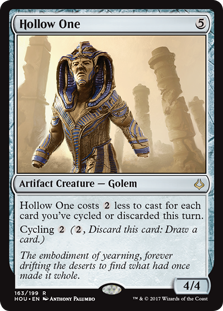 archetypes, but pieces of a greater whole. Players are trying to hybridize Hollow One with UR Phoenix, and on paper that deck is terrifying. However, something is missing that keeps the deck in check. Whether that missing piece is an existing though obscure card or simply doesn't exist yet is impossible to say. If it is found and the potential of Hollow Phoenix is realized, then there could be a problem. A deck that can go huge quickly, attack from multiple angles, and win uninteractively is potentially devastating.
archetypes, but pieces of a greater whole. Players are trying to hybridize Hollow One with UR Phoenix, and on paper that deck is terrifying. However, something is missing that keeps the deck in check. Whether that missing piece is an existing though obscure card or simply doesn't exist yet is impossible to say. If it is found and the potential of Hollow Phoenix is realized, then there could be a problem. A deck that can go huge quickly, attack from multiple angles, and win uninteractively is potentially devastating.
Krark-Clan Ironworks
Ever since Matt Nass's legendary run last spring, the revived Ironworks deck has been looming in player's minds. The deck is usually considered unfun to play against; it's uninteractive and takes forever, which  ultimately caused a previous banning. The new version is somewhat faster, more consistent, and integrates a powerful answer in Engineered Explosives. It can beat almost any hate and power through most disruption, and consistently thanks to all the cantrips. Incredibly powerful, fast, resilient, and frustrating combos tend to get banned in Modern.
ultimately caused a previous banning. The new version is somewhat faster, more consistent, and integrates a powerful answer in Engineered Explosives. It can beat almost any hate and power through most disruption, and consistently thanks to all the cantrips. Incredibly powerful, fast, resilient, and frustrating combos tend to get banned in Modern.
If Ironworks is to be targeted specifically, then the namesake card is the thing to hit. Krark-Clan Ironworks is an incredibly powerful engine, and the deck doesn't work without it. It also gets dinged because of its weird rules interactions thanks to being a mana ability. Without Ironworks itself, this style of slower, not-quite-deterministic combo isn't viable anymore.
Why It Won't Be Banned
There's absolutely no evidence to say that Ironworks needs a ban. Simply put, Ironworks does not have the metagame presence to justify Wizards taking action. In addition, tournaments haven't had the same problems because of Ironworks as Eggs caused.
Whether it should go because of the rules complication is irrelevant. Wizards only bans weird cards when they don't actually work within normal Magic, like Chaos Orb. Modern itself is chock-full of quirky interactions. Players who participate in competitive Magic should have enough of a grasp on the rules to understand how Ironworks actually works so that's not a reason to ban a card.
How It Could Be Banned
The main reason that players haven't adopted Ironworks, even real combo players, is the stigma surrounding it. Much like Amulet Bloom before it, Ironworks is notoriously hard to play. There is a lot that goes into the combo and its numerous loops, which translates into mental strain. 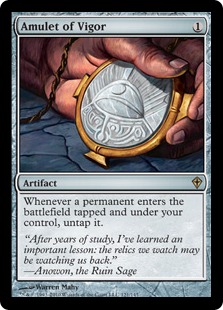 Over the course of a tournament, that all adds up. This is all well known, and very intimidating for those who might pick Ironworks up. A lot of players don't want to put in the time and effort necessary to learn the deck, so it has never had the metagame share its supposed power level suggests it should.
Over the course of a tournament, that all adds up. This is all well known, and very intimidating for those who might pick Ironworks up. A lot of players don't want to put in the time and effort necessary to learn the deck, so it has never had the metagame share its supposed power level suggests it should.
If this stigma is overcome, as many think it should be, then Ironworks might finally gain the metagame share to be a threat. The deck is certainly strong and resilient enough to really take over, as previously mentioned. The only hate that Explosives can't answer is Stony Silence, for which Ironworks plays four Nature's Claim. If players are finally prompted to pick up the deck in high numbers, then Wizards may need to take action.
Bridge from Below
On the basis that it has a negligible metagame presence, Bridge from Below certainly doesn't 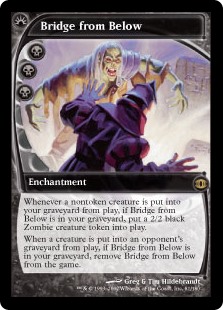 warrant any action. However, it is closer than the statistics indicate. As we saw over the summer, decks abusing Bridge and Vengevine are capable of blistering starts and of winning on turns 2-3. Bridge is the key to those wins, and intrinsic to the viability of those decks.
warrant any action. However, it is closer than the statistics indicate. As we saw over the summer, decks abusing Bridge and Vengevine are capable of blistering starts and of winning on turns 2-3. Bridge is the key to those wins, and intrinsic to the viability of those decks.
The normal gameplay for Bridge decks is to use some enabler to get Vengevine into the graveyard and then into play turn 1-2. This is done by paying 0 for cards like Endless One and Walking Ballista to trigger the plant. With a Bridge also in the 'yard, those enablers turn into 2/2 Zombies, allowing Bridge decks to present ridiculous amounts of power, ridiculously early. Throw in a Goblin Bushwacker and you've got a ridiculous kill turn.
Why It Won't Be Banned
The key is consistency, which is why the deck has virtually disappeared despite all the attention it received. Those ridiculously explosive turns are very hard to pull off in practice. The enablers are good, but not good enough to really break the deck. Looting and Stitcher's Supplier aren't enough to fix a mediocre hand on their own, because the deck needs a lot of pieces to get going. It usually takes multiple enablers and some luck to really set the deck on fire. If anything goes slightly wrong, or a promising start fails to pan out, the deck is mediocre at best. It's glass cannon with a faulty ignition and just doesn't have much success as a result. Therefore, no action is necessary.
How It Could Be Banned
If the right enabler or another payoff card for Bridgevine gets printed, then Bridge from Below could get banned. It could be some improvement to Supplier, or a new and better way to trigger Vengevine; anything to reduce the gulf between Bridgevine's best and worst starts. The key to making the deck dangerous is improving its consistency, and considering that Wizards was willing to make Supplier this year following the Golgari Grave-Troll ban, it's quite possible.
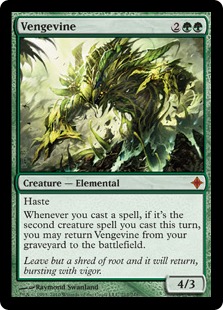 If Bridgevine becomes a problem, Bridge will get banned for two reasons. First and most important is that it is the key to those crushing starts. A couple 4/3's on turn two is threatening, but can be efficiently answered with Reflector Mage or Path to Exile. Add in a Zombie swarm and the only real answer is a sweeper, which very few decks have these days. Bridge is the card that really makes the mediocre creatures dangerous, and so is the best enabler.
If Bridgevine becomes a problem, Bridge will get banned for two reasons. First and most important is that it is the key to those crushing starts. A couple 4/3's on turn two is threatening, but can be efficiently answered with Reflector Mage or Path to Exile. Add in a Zombie swarm and the only real answer is a sweeper, which very few decks have these days. Bridge is the card that really makes the mediocre creatures dangerous, and so is the best enabler.
The second reason is that doing so would also be a targeted ban. Bridge has never been a fair card, instead being a combo piece; just compare Modern Dredge to Legacy.
What Won't be Banned
I was surprised by how short my list was, especially considering how many cards I've railed against over the years. However, the metagame is in a pretty good place, and shifts over the past year have largely eliminated many cards from contention. It's not impossible for the cards to become dangerous, as anything can be printed. However, the circumstances that need to align to make it happen are so unlikely as to be implausible in the near future. Therefore, I'll argue that these cards will not be banned, nor should they be, and players should stop considering them.
Ancient Stirrings
I despise this card. I'm clearly not alone. It is such a powerful cantrip; the most powerful ever in the right shell. Considering that Preordain and Ponder are already banned, it's incredibly unfair that the arguably unfair colorless decks get a one mana Impulse. To keep Tron and artifact combo down, many believe Stirrings should be banned.
The Reality
 It pains me to say this, but the chances of Ancient Stirrings getting banned are remote at best. The only deck that really needs Stirrings and can play it is Tron, and Tron just isn't the threat it used to be. Stirrings sees a lot of play, but in most decks is replaceable. Ironworks and Lantern could easily play another bauble effect and barely feel anything. Hardened Affinity doesn't always play Stirrings. The only reason to hit Stirrings anymore is to kill Tron, which really needs the consistency to remain viable in an increasingly hostile world.
It pains me to say this, but the chances of Ancient Stirrings getting banned are remote at best. The only deck that really needs Stirrings and can play it is Tron, and Tron just isn't the threat it used to be. Stirrings sees a lot of play, but in most decks is replaceable. Ironworks and Lantern could easily play another bauble effect and barely feel anything. Hardened Affinity doesn't always play Stirrings. The only reason to hit Stirrings anymore is to kill Tron, which really needs the consistency to remain viable in an increasingly hostile world.
What Needs to Change?
Tron needs to really take over, which is beyond unlikely, or some new degenerate deck must emerge that really abuses and relies on Stirrings. As colorless-matters was largely a mistake and won't return in numbers for a while, this seems very unlikely.
Mox Opal
It has been argued since Modern became a thing that it is unfair for Affinity to get a Mox and nobody else. Affinity's most explosive starts are all thanks to Mox Opal, and now other hated decks like Lantern and Ironworks use it too. Fast mana is a problem, so should there be any Moxen in Modern?
The Reality
There isn't anything in the current cardpool that uniquely supercharges Opal to the point that a ban is justified. Right now, the artifact decks aren't taking over the metagame, and old-school Affinity is barely a deck anymore. If the Hardened Scales version proves too good (unlikely), it makes far more sense to ban Scales itself, since it's what actually facilitates its overwhelming starts.
 I would argue that the only thing keeping artifact aggro remotely viable at the moment is the acceleration from Opal. No other deck has access to a Mox, despite some noble attempts with Mox Amber, and there isn't really another reason to play artifacts over normal aggro. Affinity is so vulnerable to hate and clunking out that it needs the speed boost. In this way, Opal contributes to format diversity.
I would argue that the only thing keeping artifact aggro remotely viable at the moment is the acceleration from Opal. No other deck has access to a Mox, despite some noble attempts with Mox Amber, and there isn't really another reason to play artifacts over normal aggro. Affinity is so vulnerable to hate and clunking out that it needs the speed boost. In this way, Opal contributes to format diversity.
As for combo applications, namely Ironworks, Opal is a merely nice addition. I've discussed Opal's impact on the deck before, and it's a fine bonus, but not the real power card. The acceleration is often marginal. As I said above, if Ironworks requires a ban, it makes the most sense to just axe its namesake.
What Needs to Change?
In short, another artifact block. There needs to be some kind of new artifact payoff or deck that really abuses Opal's acceleration, but only needs to have its explosiveness specifically reduced. At this point, a currently existing deck justifying a ban is unlikely. Considering how often artifact-themed sets get Wizards into trouble, and how aware they are of this fact, it's pretty unlikely that they'll make such a set for some time nor include pushed artifacts in a regular set.
Expect Nothing
As mentioned, these are the cards that could potentially get banned. I don't think there's much of a reason to think they will, nor that anything will happen with the Modern Banned and Restricted List in 2019 period. It is always fun to speculate, but if history has taught us anything, the banlist is in for another uneventful year.





I agree with what you said David. Now that Standard is back to being good again I think less focus on controlling Modern is happening. WOTC knew Standard wasn’t in good shape but they wanted to retain their players so they made sure they could keep playing Magic by making Modern attractive for the meantime. We’ve seen this pattern all the time in Modern when a new archetype rises and slowly fades down as everyone starts getting familiar and figuring out ways to beat it. It is normally to want to play the new hype and all. People like that feeling of playing the new “best” deck until it begins to look like just another good strategy. I don’t think we’re going to see any changes to Modern for awhile.